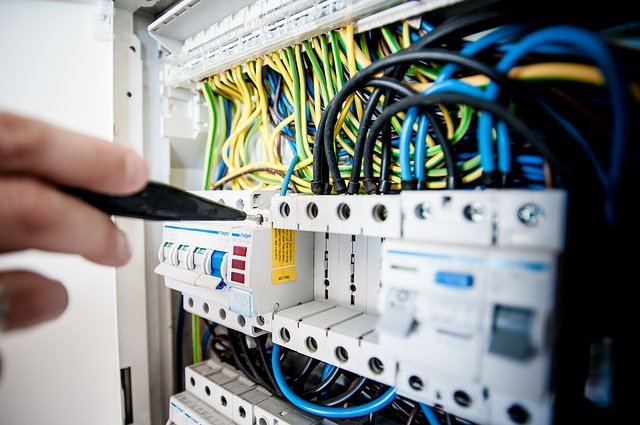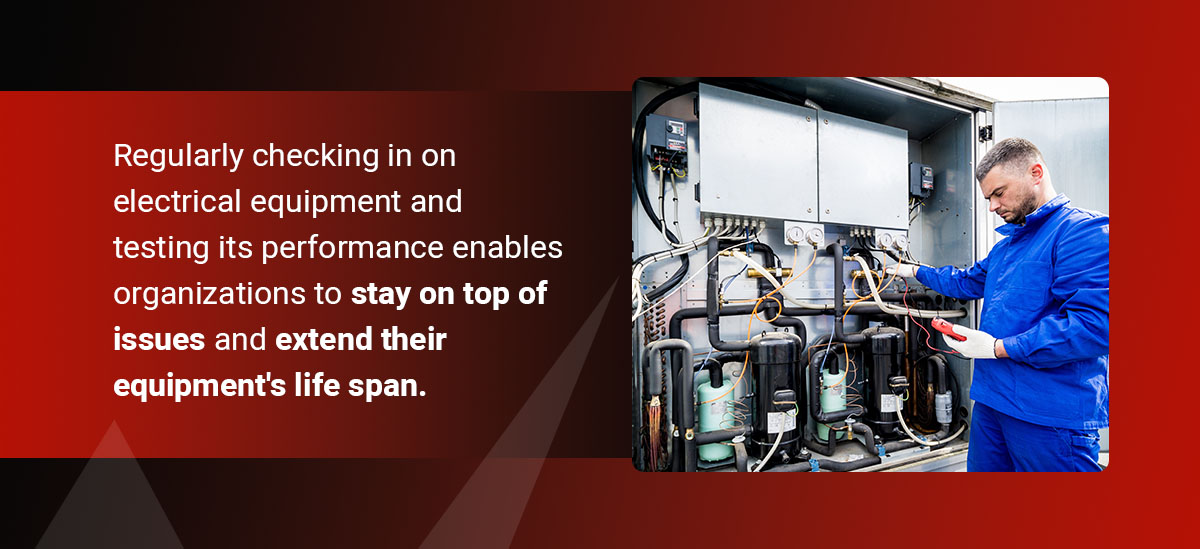If you work with industrial electrical equipment, you know how crucial it is that every device operates effectively. Electrical acceptance testing is a procedure that supports the quality assurance and functionality of electrical Components and Equipment.
Jump to:
- What Is Electrical Acceptance Testing?
- Why Does It Matter?
- Acceptance Testing Specifications for Electrical Power
- Types of Tests
- When to Test Electrical Equipment
- The Importance of Routine Electrical Testing
- Electrical Preventive Maintenance Program
- Count on Power Products & Solutions for Electrical Services
What Is Electrical Acceptance Testing?
Acceptance testing of electrical equipment ensures that all devices are working correctly. It accounts for any applicable operation standards and manufacturer’s tolerances to guarantee proper usage and function. Comprehensive acceptance testing happens in four stages:
- Factory testing: This type occurs after completion of the product and before shipping to ensure the build is correct. During this stage, technicians fix any manufacturing flaws that may have occurred during production.
- Testing upon receipt: At this stage, electrical equipment gets examined upon delivery. A trained technician will perform tests before the buyer signs for the product to prove the equipment survived shipping without sustaining damage.
- Installation testing: When electrical equipment is installed, acceptance testing verifies all devices were set up according to any applicable standards.
- Functional testing: The final stage of acceptance testing runs machinery through a “real-world” scenario to affirm its readiness for the jobs it will perform.
Why Does It Matter?
When a piece of electrical equipment performs real work for the first time, this is a unique experience for the device. It could present malfunctions or operational failures that would go unnoticed in the manufacturing stage. Electrical acceptance testing repeatedly examines a component’s function to prepare it for real work to the greatest possible extent. The functional stage mimics actual processes as closely as is feasible to reduce the possibility of failure.
Acceptance testing also validates the manufacturer’s warranty to confirm the product is built well and prepared to last. Buyers deserve materials that will offer a long service life, and manufacturers want to provide them.
Insurance companies may also request electrical acceptance testing for liability purposes. Any industrial or manufacturing company will have some type of insurance, and they may even wish to insure their large machinery. Acceptance testing provides security against the insurance company having to make a big payout for failed machines.
Ultimately, electrical acceptance testing confirms your equipment will function, and that it will do so safely and efficiently. Workers using high voltage devices deserve guaranteed safety, and added efficiency is always a good trait for a product line or operation.
Acceptance Testing Specifications for Electrical Power
The American National Standards Institute (ANSI) works in conjunction with the International Electrical Testing Association (NETA) to create acceptance testing specifications for electrical devices. These specifications involve pages of testing codes and standards for every type of test procedure. Specific processes are required for all electrical equipment, while others are optional.
Regardless of the devices needing acceptance testing, ANSI and NETA require a licensed technician to perform the assessments. The technician also has to be hired under a NETA-certified organization. Other requirements include safety measures and test equipment calibration.
Another ANSI/NETA requirement for electrical testing is a compiled test report. Documentation is a vital part of the process because it tracks any errors and tests for future reference. It outlines details like the technician’s name, environmental conditions on the testing day, and any tests and inspections performed. All test reports must include the following:
- A project summary
- Description of equipment
- Explanation of tests performed
- Test results and data
- Analysis of data and recommendations for improvement
These thorough standards ensure that all electrical acceptance testing is completed in the same way in every location.
Types of Tests
ANSI and NETA standards describe a wide variety of tests for technicians to perform that include looking at circuit capabilities and the overall quality of a device. Certain types of tests are valuable for all classes of electrical equipment. These tests include:
- Visual inspection: While this isn’t classified as an acceptance test, it is outlined in NETA requirements. Technicians will look at all aspects of a piece of machinery to see that everything appears to be in good shape.
- High current testing: This study examines the reliability of the electrical devices see how much thermal energy they can withstand.
- Relay testing: A protective relay is a device designed to trip a circuit breaker when a fault is detected. This exam looks at a relay’s response times and its highest functional frequency.
- Power factor test: Power factor tests examine the integrity of component insulation and how it will hold up with wear.
- Full electrical testing: This type involves all aspects of an electrical device, and testing practices vary depending on the part. ANSI and NETA outline all the requirements.
When to Test Electrical Equipment
Testing frequency for electrical equipment can range from months to years depending on the type of business and its equipment use. General testing guidelines include:
- Every three months for high-risk environments, such as construction sites
- Every six months for moderately high-risk environments, such as manufacturing facilities
- Every year for moderately low-risk environments, such as hotels and schools
- Every two to five years for low-risk environments, such as offices and server rooms
High-risk environments often require more frequent electrical equipment testing to ensure equipment operates effectively and safely. In low-risk environments, the equipment has more protection from outside forces, meaning it needs less testing to check its safety and operational quality. While most testing methods follow this general outline, some organizations may need to test and inspect more or less frequently depending on their equipment needs and usage. Equipment that experiences heavy wear or constant disconnection and reconnection are potential items that need more frequent testing.
Prioritizing regular visual inspections can ensure equipment is operating efficiently between testing periods. Inspections can reveal issues that require immediate attention, areas needing cleaning and basic repair opportunities. These inspections can help extend equipment life and increase productivity.
The Importance of Routine Electrical Testing
Routine electrical testing is an essential practice for businesses across industries. Regularly checking in on electrical equipment and testing its performance enables organizations to stay on top of issues and extend their equipment’s life span. Performing routine electrical testing allows businesses to experience benefits such as:
- Improved safety: Electrical issues put individuals and property at risk. Regular testing can enable organizations to identify and resolve any minor electrical issues before they escalate into significant safety problems. Inspections and tests can locate damage, defects and deterioration to help equipment run as safely and efficiently as possible.
- Enhanced equipment reliability: Routine electrical testing ensures equipment always performs optimally. These tests can help address electrical issues so organizations can ensure their equipment works correctly and lasts or exceeds its expected life span. Regularly inspecting electrical equipment keeps businesses informed about their investments’ dependability.
- Increased cost savings: With routine testing, companies can promptly address minor electrical issues to prevent expensive damage, repairs and downtime in the future. Businesses can save on replacement costs by regularly inspecting and cleaning components. Frequent testing can also ensure electrical equipment runs as effectively and efficiently as possible, saving on energy and operational delay costs.
Electrical Preventive Maintenance Program
Along with electrical acceptance testing, NETA formed standards for Maintenance Testing Specifications (MTS) for electrical preventative maintenance. MTS is a way to use preventive testing standards throughout a machine’s lifespan. This practice reduces the need for larger repairs and potentially dangerous electrical failures. NETA has outlined the necessities for all MTS programs — these requirements include:
- Licensed personnel.
- Full understanding of maintenance requirements.
- Routine tests and inspections.
- Test report analysis.
- Plans for corrective measures.
- Application of necessary work.
- Collection of data and essential records.
Using these methods together can help sustain the quality of electrical equipment.
Count on Power Products & Solutions for Electrical Services
Power Products & Solutions specializes in electrical acceptance and preventive maintenance testing, and we have over 30 years of experience providing comprehensive power systems service to clients throughout the United States of America. We know how much you rely on your electrical equipment to keep operations moving, so our NETA-certified technicians are here to ensure your machines are ready to run from the moment of installation.
We also continue to serve you throughout the life of your equipment, offering preventive maintenance and 24/7/365 emergency service to keep downtime to an absolute minimum — with Power Products & Solutions, you’re never on your own. Call or contact us online today to request electrical acceptance testing or additional information about our products and services.
Contact Us


